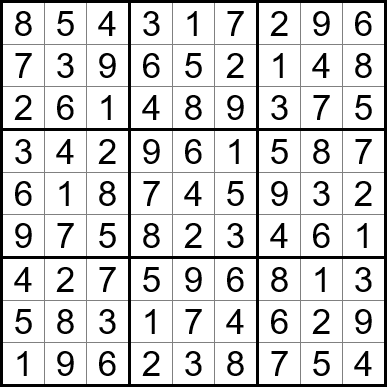Welcome, puzzle enthusiasts, to another exciting puzzle-solving adventure! In this guide. Have you’ve been scratching your head, wondering how to solve Sudoku Puzzles? You’ve come to the right place. In this blog I’ll take you through the fascinating world of Sudoku and equip you with the strategies and techniques needed to conquer those perplexing grids. So, grab your pencils and get ready to unlock the secrets of Sudoku mastery!
Understanding the Sudoku Grid

Before we dive into solving Sudoku puzzles, let’s familiarize ourselves with the structure of the grid. A Sudoku grid consists of a 9×9 layout, divided into regions, rows, and columns. In other words, every region, column, and row each has nine boxes or squares. Each region and all rows and columns must contain unique numbers from 1 to 9. This systematic arrangement forms the foundation of every Sudoku puzzle.
Rules of Sudoku

How To Solve A Sudoku Puzzle
To embark on your Sudoku-solving journey, it’s crucial to understand the rules of the game. The objective is simple: fill the entire grid with numbers from 1 to 9, ensuring that no row, column, or region contains duplicate numbers. Remember, each number can only appear once in each region, row and column.
Looking at the completed grid above you will see that each region has the numbers 1-9, each row has the numbers 1-9 and each column had the numbers 1-9. It’s important to remember that no region, row or column can duplicate numbers.
Getting Started
Ready to tackle your first Sudoku puzzle? Start by scanning the grid for empty squares and identifying any given numbers. Begin with easy puzzles to build confidence and gradually progress to more challenging ones. Patience and practice are key!
Tips for Solving Sudoku Puzzles
- Use a Pencil: When solving Sudoku puzzles, it’s best to use a pencil instead of a pen. This allows you to easily make changes and erase any mistakes without creating a messy grid.
- Start with the Basics: Begin by focusing on the empty squares that have the most given numbers. By identifying squares with multiple given numbers, you’ll have a head start in solving the puzzle.
- Take Notes: Make small notations or candidate lists in the empty squares to keep track of potential numbers. This helps you visualize the possibilities and eliminate incorrect options as you progress.
- Work in Sections: Break down the puzzle into regions, rows, and columns, and systematically solve each section. By focusing on one area at a time, you’ll avoid confusion and ensure accuracy.
- Eliminate Possibilities: Look for opportunities to eliminate possibilities. If a number is already present in a row, column, or region, you can exclude it as a candidate for other empty squares in that segment.
- Check for Unique Candidates: Identify squares that have only one remaining candidate number. These squares can be filled in immediately, as there is no ambiguity about their value.
- Review and Double-Check: Regularly review the filled-in numbers and double-check for errors or inconsistencies. Correcting mistakes early prevents them from affecting the rest of your solving process.
- Practice Patience: Sudoku puzzles require concentration and patience. Don’t rush through the grid. Take your time, analyze the possibilities, and make logical deductions.
- Take Breaks: If you find yourself stuck or feeling overwhelmed, take short breaks. Stepping away from the puzzle for a while can provide a fresh perspective when you return.
- Every Sudoku has only one solution, so double-check by making sure each column, row, and square contains the numbers 1-9 with no duplicates or omissions.
- Practice, Practice, Practice: The more you solve Sudoku puzzles, the more familiar you become with the strategies and techniques. Regular practice improves your solving speed and accuracy over time.
Strategies for Solving Sudoku Puzzles
How do you solve a sudoku puzzle? Let’s explore some effective strategies for cracking those Sudoku mysteries. These techniques will help you navigate through the grid and unveil the hidden numbers.
Strategy 1: Single Possibility Technique
Look for squares with only one possible number based on the existing numbers in the grid. These squares act as clues and provide a starting point for your solving journey. Fill in the single possibility and watch as the puzzle unfolds.
Strategy 2: Elimination Technique
Employ the power of elimination by analyzing rows, columns, and regions. Look for numbers that already exist in these segments and eliminate them as possibilities for other squares. By narrowing down the options, you’ll gradually uncover the correct numbers.
Strategy 3: Candidate Lists
Create candidate lists for each square, noting down the potential numbers that can fit based on the surrounding clues. As you progress, update the lists by eliminating numbers that are no longer possible. These lists will become your trusty companions in unraveling the puzzle’s secrets.
Here’s how you can create and utilize a candidate list:
- Begin by looking at an unsolved Sudoku puzzle grid.
- Analyze each empty square: Focus on one empty square at a time and examine the numbers in its corresponding row, column, and region.
- Identify potential numbers: Based on the numbers already present in the surrounding cells, identify the possible numbers that can fit into the empty square. For example, if the numbers 1, 3, 5, and 8 are present in the row, column, or region, the remaining potential numbers would be 2, 4, 6, 7, and 9.
- Note down the potential numbers: Create a list or annotate the empty square with the potential numbers that can go into it. This list is your candidate list for that square.
- Update the candidate list: As you fill in more numbers and make progress in solving the puzzle, update the candidate lists accordingly. Eliminate numbers from the candidate list if they are no longer valid based on the new information.
By maintaining and updating the candidate list for each empty square, you’ll have a visual representation of the potential numbers that can be placed in that square. The candidate list helps you make informed decisions and deductions while solving the Sudoku puzzle.
Remember, the candidate list is not a foolproof solution, but it serves as a valuable aid in your solving process, especially in more challenging puzzles where multiple possibilities exist.
Strategy 4: “What If” Technique
Sometimes, a little educated guesswork is necessary. Use the “what if” strategy by making an informed guess for a square and exploring its implications. If your guess leads to contradictions down the line, backtrack and try a different approach. This technique can be a game-changer for complex puzzles.
Strategy 5: X-Wing and Swordfish Techniques
For the daring Sudoku solvers among us, advanced techniques like X-Wing and Swordfish come into play. These strategies involve spotting patterns in rows and columns that allow you to eliminate possibilities and uncover the correct numbers. Don’t be intimidated—embrace the challenge!
X-Wing Technique: Simplified Explanation
The X-Wing technique is a powerful strategy for solving Sudoku puzzles. It involves finding a special pattern that looks like an “X” or an “H” in the puzzle grid. By identifying this pattern and following a few steps, you can eliminate certain numbers and make progress in solving the puzzle.
Here’s how it works in simpler terms:
- Look for the X-Wing Pattern: Search for two rows or columns in the Sudoku grid where the same two numbers (let’s call them A and B) appear as candidates only twice, forming a rectangular shape that looks like an “X” or an “H”.
- Focus on those Rows or Columns: Pay attention to the rows or columns where the A and B numbers appear. These will be the main areas of interest for the X-Wing technique.
- Check the Intersecting Rows or Columns: Look at the other rows or columns that intersect with the main areas of interest. If any of these intersecting rows or columns also contain the A or B numbers as candidates, you can remove those numbers as possibilities from the cells in those intersecting rows or columns.
- Eliminate Candidates: Cross off or remove the A and B numbers from the cells in the intersecting rows or columns. This is possible because the A and B numbers in the main areas of interest force those numbers to appear only once in the intersecting rows or columns.
- Keep Solving: After applying the X-Wing technique, reassess the puzzle and see if any new opportunities arise from the eliminations. Then, continue using other solving strategies and techniques to move closer to completing the Sudoku puzzle.
By using the X-Wing technique, you can identify a special pattern, eliminate certain numbers based on that pattern, and gain more clues to solve the puzzle. Remember, practice makes perfect, so keep trying different techniques and strategies to improve your Sudoku-solving skills!
The X-Wing technique may seem a bit complex at first, but with some practice, you’ll become comfortable spotting the pattern and using it to your advantage. Have fun with your Sudoku adventures!
Swordfish Technique: Advanced
The Swordfish technique is an advanced solving strategy that can help you tackle challenging Sudoku puzzles. This technique cannot be used on every puzzle as not every puzzle has a swordfish pattern—but as you progress, you may run into more difficult puzzles where this technique can be helpful. It involves identifying a specific pattern that occurs in rows or columns, leading to the elimination of candidate numbers and revealing the correct placements.
How does it work?
- Spotting the Swordfish Pattern: Begin by scanning the puzzle grid to find rows or columns where a specific candidate number (let’s call it X) appears in three different columns or rows, and each of these three columns or rows contains a maximum of three occurrences of the candidate number X.
- Focusing on Rows or Columns: Once you identify the Swordfish pattern, focus on the rows or columns where the candidate number X appears. These rows or columns will serve as the primary areas of interest for this technique.
- Analyzing the Impact: Examine the other rows or columns that also contain the candidate number X. If any of these intersecting rows or columns contain the candidate number X only in the same three columns or rows as the primary areas of interest, you can eliminate the candidate number X from the remaining cells in those intersecting rows or columns.
- Eliminating Candidates: Remove the candidate number X from the cells that lie in the intersecting rows or columns. This elimination is possible because the candidate number X must appear exactly once in each of the three columns or rows, forcing its placement in the primary areas of interest and excluding it from other cells in the intersecting rows or columns.
- Progressing in Solving: After applying the Swordfish technique, reevaluate the puzzle and look for new opportunities that may arise as a result of the eliminations. Continue applying other solving strategies and techniques to further progress towards solving the Sudoku puzzle.
Remember, the Swordfish technique is just one of the advanced strategies at your disposal. Combine it with other techniques, such as the X-Wing and advanced elimination methods, to conquer even the most challenging Sudoku puzzles.
Mistakes to Avoid
As you venture into the Sudoku realm, beware of common pitfalls that can hinder your progress. Stay on the right track with these tips:
Mistake 1: Duplicate Numbers
Always double-check for duplicate numbers in rows, columns, and regions. A single slip-up can throw off the entire puzzle. Take a moment to ensure the numbers in each segment are unique, and you’ll avoid frustration down the line.
Mistake 2: Incorrect Guesses
While educated guesses are part of the solving process, be vigilant in verifying your assumptions. If your guess leads to contradictions or conflicts, backtrack and reassess your strategy. Precision is key to cracking the Sudoku code.
Mistake 3: Missing Hidden Numbers
Don’t overlook the importance of hidden numbers. These elusive clues can be the missing link in solving the puzzle. Train your eye to spot them and incorporate them into your solving techniques. They might hold the key to unlocking the entire grid.
Hidden numbers in Sudoku refer to the numbers that are not explicitly provided as clues in the initial puzzle setup. These hidden numbers play a significant role in solving the puzzle as they are the missing links needed to fill in the remaining empty squares.
Identifying Hidden Numbers:
- Analyzing Rows, Columns, and Regions: To find hidden numbers, carefully examine each row, column, and region of the Sudoku grid. Look for numbers that are missing or not yet filled in.
- Spotting Patterns and Relationships: Hidden numbers often reveal themselves through patterns and relationships within the puzzle. Analyze the existing numbers and their placement in each row, column, and region to identify the missing numbers.
- Deductive Reasoning: Use deductive reasoning to determine the potential candidates for the empty squares. By considering the numbers already present in a particular row, column, or region, you can deduce which numbers are missing and, therefore, are hidden.
Practicing and Improving
As with any skill, practice makes perfect. Enhance your Sudoku-solving abilities by dedicating regular time to puzzles. Engage with puzzle books, explore online platforms, or download mobile apps that offer a wide range of Sudoku challenges. The more you practice, the sharper your problem-solving skills will become.
FAQs
Can you solve every Sudoku without guessing?
Yes, absolutely! While guessing can be a part of the process, it’s not always necessary. By employing various solving techniques, such as the elimination method and candidate lists, you can solve Sudoku puzzles without relying heavily on guesswork. Give it a try and see the grid unfold before your eyes!
What strategies should I use for difficult Sudoku puzzles?
Difficult Sudoku puzzles require a strategic approach. When tackling challenging grids, make sure you’re well-versed in advanced techniques like X-Wing and Swordfish. These methods help identify patterns that allow for the elimination of possibilities and ultimately lead to the correct solution. Practice these strategies, and you’ll conquer even the most daunting puzzles.
How can I improve my Sudoku-solving speed?
Improving your speed in solving Sudoku puzzles comes with practice and familiarity. Start by solving puzzles of varying difficulty levels regularly. As you gain experience, your solving skills will become more efficient, and you’ll naturally solve puzzles more quickly. Additionally, try setting time goals for yourself and challenge friends or participate in Sudoku competitions to further enhance your speed and accuracy.
Additional Reading
Conclusion
Congratulations, fellow puzzle enthusiasts! You’ve learned the ins and outs of how to solve any Sudoku puzzle like a true pro. Remember to understand the Sudoku grid, abide by the rules, and employ a variety of strategies. Avoid common mistakes, stay patient, and practice regularly.
Remember, Sudoku is a game of logic and deduction. With practice and perseverance, you’ll become a skilled Sudoku solver. So, grab your pencil, embrace the challenge, and enjoy the satisfaction of unraveling those numerical mysteries!
Do you have any tips or tricks for solving Sudoku puzzles? Please comment below.






A note about coding process . . . it’s helpful to list out missing numbers in a grid by utilizing the same pattern for each by letting 1 2 3 fill the upper third, 4 5 6 the middle and 7 8 9 for the lower. For a further challenge, once you’ve had some success with this, switch over to a binary method where each number is represented by a slash in the position on the unsolved square where the missing number would reside. For a busy puzzle the binary method can save you time in writing and ease in erasing but it will force you to concentrate even harder until you become comfortable without seeing numbers written out.
Kevin,
Thank you for your comment! Utilizing a consistent pattern to list out missing numbers in a grid sounds like a great strategy for tackling Sudoku puzzles.Transitioning to a binary method once the basic pattern becomes familiar is a great suggestion.
I’ll definitely give these methods a try and see how they enhance my solving process. Thanks again for sharing your tips!
Best regards,
Debbie
Replace “grid” with “unsolved square” in previous comments
Kevin,
I edited your comment to read “unsolved square”.
Thank you again,
Debbie